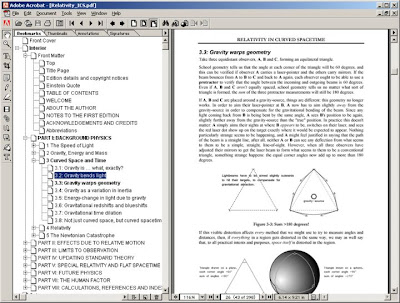 I've just provisionally put Relativity in Curved Spacetime online as an eBook, to see what happens. It's the full fixed-layout PDF file for the book, with an added "bookmark pane" PDF index and some annotations. If you're curious about the page layouts or you'd like a single-sheet PDF listing of the book's contents, click on the links.
I've just provisionally put Relativity in Curved Spacetime online as an eBook, to see what happens. It's the full fixed-layout PDF file for the book, with an added "bookmark pane" PDF index and some annotations. If you're curious about the page layouts or you'd like a single-sheet PDF listing of the book's contents, click on the links. I've initially priced the thing at USD $4-99, which comes out as about three quid in British Pounds. That's about a third of what Apple are going to be charging for ebooks.
If you want a nicely-bound hardcopy, and don't fancy printing off nearly 400 sides of paper, you can still buy the paperback and hardback. Otherwise, the PDF version's on Payloadz.com .




2 comments:
Erk,
I have downloaded your book, even though I have a paperback copy. The eBook easier for searching. It is a great book, apart from the anti-SR parts, and there are many!
Remember my problem with your derivation of E = mc² in "Isaac Newton and E=mc²" and "Momentum and Kinetic Energy"? The problem was that the emission theory Doppler shift does not take account of the loss of kinetic energy that accompanies the loss of mass. You decided that the lost energy was part of the imbalance of frequencies, but I explained that the momentum and imbalance can be cancelled while doubling the kinetic energy by also considering a 2nd particle travelling in the opposite direction. This means your idea doesn't seem to conserve energy.
A couple of other problems:
About time dilation you give, "...we can't in principle isolate the SR time dilation effect in a
particle moving at constant speed along a straight track, because if we could prove how much
time dilation it really had, we'd have a measure of its true velocity compared to the speed of
light".
What does this mean? You seem to be trying to discredit special relativity by showing that there can be no "straight line" time dilation, but SR predicts that a "moving clock" falls further behind each lab coordinate clock, regardless of the choice of frame. The coordinate clocks are synchronised in the laboratory frame. A demonstration of this would be difficult in practice, but it is possible in principle.
Also, you suggest that particles in accelerators resist acceleration to lightspeed, not because their inertia is increasing, but because the recession energy of the coils is redshifted. But what about the blueshifted approach energy? In any case, particle physicists know that the particles do acquire the energy because of the collisions, otherwise the Large Hadron Collider would be redundant.
These 3 points are enough for now, thanks!
Michael
FYI, I stumbled onto your webpage and tried to download the Einstein relativity book. Instead, it links to the preview of your own book - can't seem to get to the Einstein book on your site. - Delaney
Post a Comment